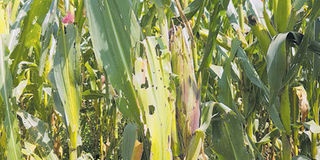Study finds some maize resistant to stem-borer

Maize crops infested by stem-borers. The pest is capable of causing yield losses of between 10 and 100 per cent in crops they affect. PHOTO | FILE | NATION MEDIA GROUP
What you need to know:
- The researchers from the International Centre of Insect Physiology and Ecology (Icipe) and its partners identified the genetic markers in the “smart maize” varieties.
- They damage plant stems by destroying the central leaves. Later, the pests also drill into maize cobs, ruin grains and increase susceptibility to aflatoxins.
- An interesting finding is that the plants recruit both egg and larval parasitic wasps.
Researchers have discovered that certain maize varieties can defend themselves against stem borers.
The researchers from the International Centre of Insect Physiology and Ecology (Icipe) and its partners identified the genetic markers in the “smart maize” varieties.
Their research, which was conducted by Icipe, Keele University and the International Crops Research Institute for the Semi-Arid Tropics (Icrisat), offers possibilities for developing maize varieties that are resistant to stem-borers.
Capable of causing yield losses of between 10 and 100 per cent, stem borers are destructive pests affecting cereal crops including maize, rice, sorghum, sugarcane and pearl millet.
The pests are most damaging in their larval stage, when they are hidden inside the stem making their control difficult.
They damage plant stems by destroying the central leaves. Later, the pests also drill into maize cobs, ruin grains and increase susceptibility to aflatoxins.
The researchers, who analysed the genetic makeup of 146 different types of maize plants, observed that when stem borers lay eggs on some maize cultivars, a defense reaction is triggered in the plants, according to Dr Amanuel Tamiru, a scientist at Icipe.
An interesting finding is that the plants recruit both egg and larval parasitic wasps.
“As such, the natural enemies kill the stemborer eggs before they hatch into larvae, as well as any larvae that may emerge, thus preventing damage on the crop,” he adds.





